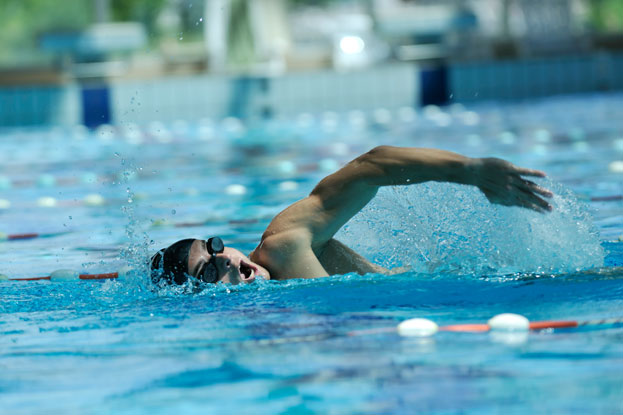Freestyle swimming, also known as the front crawl, is one of the most practiced swimming techniques. This technique is well-known for its speed and efficiency, allowing swimmers to move through the water with fluidity and power.
Before we dive into the different racing strategies in the sport of freestyle swimming, let’s look at its history.
Freestyle swimming is traced to thousands of years ago, but it became a distinct swimming stroke in the 19th century. The technique was first reported in 1844 when two Native Americans, Flying Gull and Tobacco, joined a London swimming competition. Their arm motion was likened to a windmill, while their legs were described to be kicking in an up-and-down motion.
In the early 1896 Olympic Games in Athens, there were no restrictions on the swimming stroke used in races. Swimmers were free to use any stroke they preferred, including breaststroke, backstroke, or sidestroke.
In the 1908 London Olympics, however, swimmers were allowed to use only the front crawl stroke during freestyle races. The goal of this change was to standardize the competition and eliminate confusion caused by the variety of strokes used in the competition.

Popular Racing Strategies
Are you a competitive swimmer, a recreational enthusiast, or someone learning to swim for the first time? Try learning freestyle swimming for an exhilarating experience in the water! Here are some popular racing strategies that you can try.
Sally or Sammy Save-Up
The Sally or Sammy Save-Up strategy is a pacing strategy used by swimmers during longer-distance events. You can distribute your energy and effort throughout the race to maintain speed and finish strong.
Start with the Save-Up phase wherein you swim at a slower speed to conserve energy and reserve your effort. This phase builds your momentum and maintains a consistent pace while saving energy for the later part of the race.
After the Save-Up phase, transition into the Sally or Sammy phase wherein you gradually increase your speed. Leverage your saved energy to increase your pace, overtake competitors, or make a significant surge toward the end.
The Sally or Sammy Save-Up strategy helps you avoid premature exhaustion during the race. It also allows you to finish strongly, especially in longer-distance freestyle races.
Fly-and-Die
The fly-and-die strategy in freestyle swimming is a pacing strategy used by swimmers usually during shorter-distance events. This is the preferred strategy of swimmers who are more oriented toward sprinting.
To effectively execute fly-and-die, you must have a precise judgment of your capabilities and a thorough understanding of race dynamics.
With this strategy, start a race by “flying” wherein your pace is extremely fast and aggressive. A fast start aims to gain an early advantage or create a significant lead over competitors.
Due to the excessive initial effort, however, it is inevitable to slowly transition to the dying part. You will eventually exhaust your energy reserves and slow down. With the noticeable decrease in speed at the latter part of the race, competitors can overtake you.
Some swimmers consider the fly-and-die strategy risky because it requires swimmers to heavily rely on maintaining an unsustainable pace. This strategy yields short-term advantages but often leads to diminished performance and slower overall race times.
Hence, this strategy is not recommended for events that are over 200. It’s not easy to fly or maintain speed for longer distances.
Parabolic Pacing
Parabolic pacing in freestyle swimming is a race strategy that involves intentionally varying the swimmer’s speed throughout the race to optimize performance.
The critical principle of parabolic pacing is to strategically allocate energy and effort throughout the race to avoid early exhaustion or fading toward the end of the race. To successfully execute this strategy, you must have a good understanding of your capabilities, energy management, mental focus, race distances, and competition.
With this strategy, start the race at a moderately fast but controlled pace. For the first part of the race, aim to find a balance between conserving energy and maintaining a competitive speed. The initial phase also allows you to settle into your rhythm and establish a solid foundation for the race.
In the middle portion of the competition, gradually increase your speed to gain an advantage over competitors.
In the latter part of the race, maintain your speed or slightly increase it even more. During this phase, you must sustain your momentum. The objective from the beginning is to finish the race with a strong and fast performance.
Even Splitter
Even Splitter is a pacing strategy in freestyle swimming wherein swimmers maintain a steady speed throughout the race and avoid significant fluctuations in their pace. Swimmers often use this strategy for longer-distance races.
To do so, divide the total swimming distance into equal intervals. By dividing the race into equal portions or segments, you can gauge your progress, sustain your energy, and stay on track for your target time. The goal is to complete each interval or segment of the race in the same amount of time, resulting in an even distribution of effort and energy.
For instance, you can divide a 400-meter freelance race into 100-meter segments, and then complete each segment in the same amount of time. By doing so, you can maintain a consistent rhythm at the beginning and middle portions of the race. You can also prevent early exhaustion or a significant drop in your performance later in the race.
To successfully execute the even splitter strategy, you may rely on internal cues, such as stroke count or breathing patterns, to monitor your pace and ensure consistency. During your training, you may also use pace clocks or timing devices at the poolside to track your split times.
Conclusion
Freestyle swimming can be challenging in the competitive scene. To excel at this sport, there are many things to consider, such as pacing, speed, and how well you sustain and manage your energy reserves. Find a racing strategy that works for you and you’ll surely win competitions and improve your swimming performance in no time!
